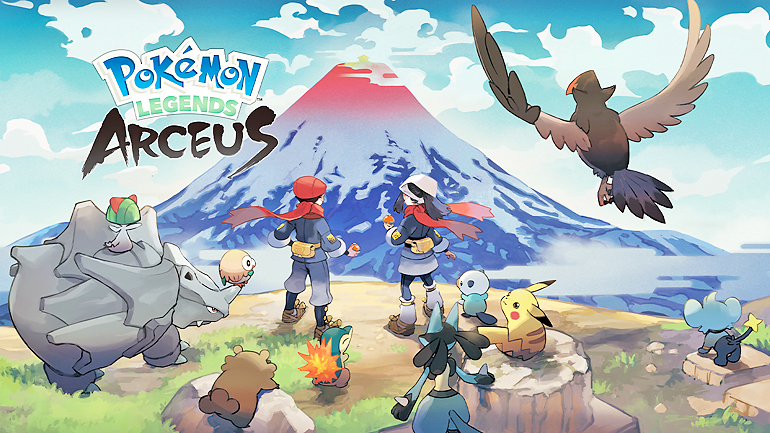Jhaan Elker
THE WASHINGTON POST – Pokémon series creator Junichi Masuda adored bug catching as a child. He loved the thrill of waiting for a rare bug, and the rush of excitement when he found one. The anticipation building before he struck, hoping to catch it.
As his collection grew, so did his sense of pride. This cycle was the foundation for one of Nintendo’s most massive franchises in its history.
Pokémon’s very existence is a love letter to this cycle, something Masuda and the developers at Game Freak hoped to replicate for players. I can definitively say after playing Pokémon Legends: Arceus that it’s the first game in the series’ over 20-year history to successfully replicate that thrill.
Pokémon Legends: Arceus has already been put through the wringer, prior to its release. When trailers were first released, everyone commented on how terrible the game’s graphics seemed.
It was easy to draw comparisons to another Switch title The Legend of Zelda: Breath of the Wild and it was even easier to point out how much worse Pokémon Legends: Arceus looked.
There were jagged edges, blurry pixelation, flat textures and more that emphasised just how out of its league Pokémon felt relative to its Zelda counterpart. And yet, because of the Masuda bug-catching cycle I mentioned earlier, Pokémon Legends: Arceus still manages to be a beautiful game. The Pokémon series has always been about more than its graphics, and this game exemplifies that.
Pokémon Legends: Arceus begins in Hisui, a setting unlike that in any other Pokémon game. It’s set during a time where the relationship between Pokémon and humans isn’t established yet, and humans are – rightfully – still terrified of the awesome, destructive power Pokémon possess. As somebody who’s okay with approaching these beasts and catching them, you’re immediately tasked by this region’s professor to catch as many of them as you can so that humanity can better understand these creatures.
The game quickly establishes that it’s different from previous games by giving you a new Pokédex. Unlike other games, where a Pokédex entry would be fully filled out the second you captured a new Pokémon, this game requires you to capture several of the same variety and in different ways that are new to the main series. It’s a clever way to consistently make every engagement with Pokémon interesting, even if it’s a Pokémon you’ve encountered before.

Supporting this is the gameplay system for encountering Pokémon, which borrows from the mobile game Pokémon Go. Whenever you approach a new Pokémon in the wild, you need to decide whether to throw a Poké Ball to try to catch it outright – a method derived from Pokémon Go – or battle it with your Pokémon before trying to catch it.
Pokémon Legends: Arceus is clever in balancing these two approaches. To catch a Pokémon without a fight, you have to successfully sneak up on it. You can’t steamroll your way through the game by just battling everything – something I’m sure most longtime fans used to those mechanics will try to do at first – because some Pokémon will get spooked and immediately run away if you try to catch them through combat.
This intriguing balance made it so I was never bored by any Pokémon encounter I faced. On top of this, the game eventually varies its challenges by presenting you with ‘Alpha Pokémon’, essentially the ‘Totem Pokémon’ equivalent of this generation that pits you against a boss Pokémon with beefed up stats. Defeating them is usually tied to a main quest line and gives you access to more of the Hisui region.
Other mechanics are clearly inspired by Breath of the Wild and previous Pokémon games. You can use a workbench to make your own items, you can cook, you can change your appearance by chatting with NPC vendors, and you eventually realise (after a lengthy tutorial) that the real joy in this game is when you can just go out and explore on your own.
What makes this game truly different, then, is how it approaches its main mechanic of “Gotta catch ‘em all!” In previous games, catching Pokémon felt woefully stilted by game mechanics and role-playing game tropes. You’d walk a bit, see a screen transition indicating a random encounter with a Pokémon that you’d hope was the one you were actually looking for, and then you’d decide to either fight or flee depending on what popped up in the RNG.
In Pokémon Legends Arceus, you can see Pokémon spawn in front of you. You can tell right away when it’s a rare Pokémon. You instinctively tense up, knowing your reflexes need to be on point to actually capture it. You feel anxious as the tension builds for the moment you know you need to strike and try to catch it. It’s the same sensation I’m sure Masuda felt way back in childhood while catching bugs, and the same one Game Freak has been trying to replicate.
This gameplay loop taps into what makes Breath of the Wild so special: It satisfies the player’s urge to just explore and be excited with what they find. Pokémon Legends: Arceus rewards exploration, and it actively encourages players to do so with rare Pokémon or unique experiences.
The game clearly has graphical problems. You will immediately notice the low framerate and how textures and objects pop-in in the background despite how close your character is to it, among other issues.
But the game proves that graphics do not make or break an experience. Hopefully, Game Freak will improve upon this aspect, and Pokémon games will eventually look as good as the public clearly expects them to be. But in the meantime, don’t discount Pokémon Legends: Arceus for its looks. It’s an experience unlike any other in the series.






